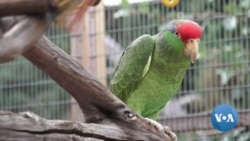At sunset every day, loud sounds can be heard coming from the sky in a community just east of Los Angeles.
The noises are from parrots. The colorful birds have become part of everyday life there.
The parrots leave their waste everywhere, said Havolynn Rose Owaleon. But she and many other community members have gotten used to the birds.
Owaleon said, "They are not quiet at all, but you know, it’s something that you listen for. Because if I didn’t hear them on a daily basis, then I know something is really wrong.”
Flying immigrants
Red-crowned parrots are now part of the ecosystem in Southern California. Their ancestors came from Tamaulipas, Mexico, where the parrots are now endangered.
The birds were often killed in their native land. But in the United States, they were sold to people as pets. Some of the parrots escaped or were released by their owners.
They have since reproduced and grown in number in an area with large numbers of people.
"They are good at making a habitat for themselves in major cities, and this is what happened in Pasadena and East L.A. So, these are birds that live pretty much exclusively off of trees that are also not native to our area," said Ursula Heise. She teaches at the University of California Los Angeles (UCLA) Department of English and at the Institute of the Environment and Sustainability.
Since arriving in Southern California, the red-crowned parrots have become such permanent fixtures that they are on the California Bird Records Committee's list of birds in the state.
“They’ve been naturalized as California citizens,” said Heise.
Cold-blooded immigrants
Often seen sunning themselves near a body of water, red-eared slider turtles are also not native to the U.S. West Coast. They also immigrated to the area as household pets. Later, some were released or escaped into the wild.
The turtles are native to the central United States. But they have survived in many parts of the country and around the world.
"Because this species is so commonly exploited for food and the pet industry, it’s the one that gets released the most often," said UCLA’s Brad Shaffer. He heads the La Kretz Center for California Conservation Science.
Urban haven
The success of the red-eared slider turtles and red-crowned parrots in the Los Angeles area has scientists wondering whether a city can be a place to help endangered non-native animals.
Shaffer said, “At least it’s living in the wild. It’s making its own living. It’s having the lifestyle that turtles or that parrots should have, it’s just doing it in a different place."
Heise noted that work crews have put up major buildings and added different kinds of plants in neighborhoods across Southern California.
In many cases, this has led to a reduction of biodiversity; the native species had trouble living in the newly created habitat.
But the other side of that, Shaffer said, is that new kinds of habitats have been created, in which some creatures could thrive. These artificial habitats could become new homes for birds, insects or other creatures whose native homes are threatened.
Shaffer said any non-native species that is added would have to be carefully chosen to limit the risk of harm to the existing wildlife population in the city and other areas.
I’m Jonathan Evans
Elizabeth Lee reported this story for VOANews.com. George Grow adapted her report for Learning English. Ashley Thompson was the editor.
_______________________________________________________________
Words in This Story
ecosystem – n. a community of organisms and its environment
pet – n. an animal kept for pleasure, not usefulness
habitat – n. an environment where a plant or animal normally lives
biodiversity – n. all forms of life in an area
minimize – v. to reduce
We want to hear from you. Write to us in the Comments Section.








